Click here to learn more about the How to Identify article series.
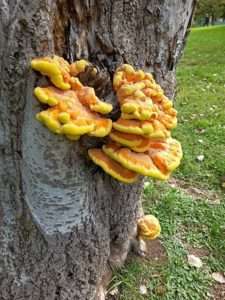
Name: Chicken of the woods (Laetiporus spp.), aka sulfur shelf, chicken mushroom (hen of the woods is a different mushroom entirely, Grifola frondosa)
Range and typical habitat(s): There are Laetiporus species found in temperate forests on every continent except Antarctica. They are especially abundant in the Northern hemisphere, particularly North America and Europe. They are saprophytes that feed on dead or injured trees and can cause brown rot as they digest cellulose but leave lignin intact. Most species prefer deciduous trees such as oaks or beeches. However, L. conifericola is an example of a species that colonizes conifers such as spruces and firs.
 Distinguishing physical characteristics (size, colors, overall shapes, detail shapes): I often describe chicken of the woods to my foraging students as looking like a pile of orange and yellow pancakes exploding out of the side of a tree. These are fleshy-looking, shelf-shaped mushrooms that often grow in large stacks or clusters. A particularly large individual shelf may be almost a foot across, and some clusters may be several feet tall. Look closely, and you will notice that these shelves do not have stems but attach directly to the host tree.
Distinguishing physical characteristics (size, colors, overall shapes, detail shapes): I often describe chicken of the woods to my foraging students as looking like a pile of orange and yellow pancakes exploding out of the side of a tree. These are fleshy-looking, shelf-shaped mushrooms that often grow in large stacks or clusters. A particularly large individual shelf may be almost a foot across, and some clusters may be several feet tall. Look closely, and you will notice that these shelves do not have stems but attach directly to the host tree.
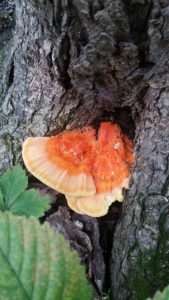
While the bright sulfur yellow and orange color combination is typical, particularly in well-known chicken of the woods species such as L. sulphureus, there may be significant color variation even within the same species. Some have a deeper orange that’s almost red, while others are a more uniform washed-out orange with little to no yellow, or perhaps cream instead. L. portentosus, which is particularly common in Australia, gets its common name, “white punk”, from its creamy white color with little to no orange. L. persicinus, found in the southeast United States and Caribbean, may have some brown on its shelves as well.
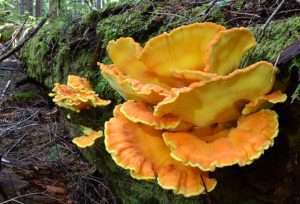
The underside of chicken of the woods tends to be yellow to cream, and while it may appear smooth at first it does have very fine pores. The spores are generally white, though a microscope may be necessary in order to differentiate between very similar species that overlap in range. Most Laetiporus species do not bruise; however, L. persicinus has pores that bruise brown shortly after being damaged.
Younger chicken of the woods tend to have a softer, more rubbery tactile texture (yes, it’s okay to touch mushrooms to see what they feel like.) As they get older, however, they get a tough, woody texture, and cooking them does not make them tender again.
Other organisms it could be confused with and how to tell the difference: Most of the time you’re going to be differentiating among multiple Laetiporus species, in which case location, color and substrate (what kind of tree it’s growing on) are going to be the main factors in identifying down to species level. If you have a microscope and want to look at the spores in detail you’re certainly welcome, but the casual identifier should be able to get by without this.
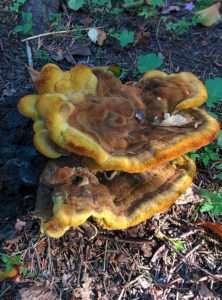
There are, however, several other shelf-like fungi with which chicken of the woods may be confused if you aren’t looking carefully. Dyer’s polypore (Phaeolus schweinitzii) may have some orange on the upper surface, especially when young, but the centers turn an increasingly dark brown as the mushroom matures. It also has a velvety texture that chicken of the woods lacks. It is found primarily on conifers, and the pores bruise brown when damaged. It has a white spore print.
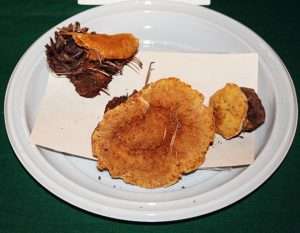
The woolly velvet polypore (Onnia tomentosa) is another look-alike. It is generally brown with a white to cream outer margin, but while the lighter brown shades may have a bit of an orange tint, the brown is a giveaway that this is not chicken of the woods. The underside is also brown, rather than white or yellow, and it primarily grows on conifers, especially spruce.
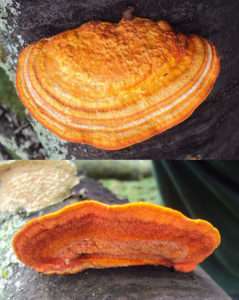
Pycnoporus cinnabarinus looks very much like a Laetiporus in shape, but is a bright red-orange color on both the top and the underside. It has a drier, less flexible texture as well, and prefers hardwood trees as hosts.
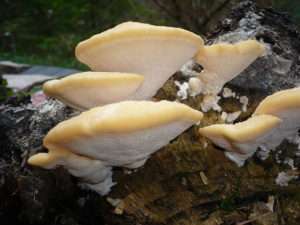
Climacocystis borealis has a hairy texture on the upper surface, and the color is a rather dull cream, yellow or orange, Underneath the pores are cream to yellow and have a more visible texture than on Laetiporus. It attaches to its host conifer trees with a short stem-like structure.
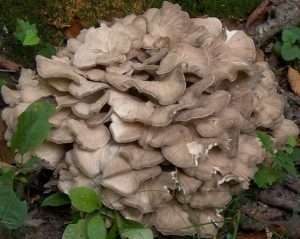
Hen of the woods (Grifola frondosa), also known as maitake, looks something like a burst of grayish-brown feathers or leaves sprouting from the base of a tree. Upon closer inspection the individual caps are much smaller, more delicate and more numerous than in Laetiporus. The pores underneath are often more visible as well. They prefer hardwoods such as oaks.
There are other shelf-shaped mushrooms in the family Fomitopsidaceae that are vaguely similar to Laetiporus species, but all differ in shape and color, among other details. Make sure you look very closely at all colors on both the topside and underside of a given shelf mushroom, check for bruising by cutting or crushing a small part and waiting a half hour, and take a spore print.
Anything else worth mentioning? Laetiporus species are generally considered to be edible, though more commonly eaten species like L. sulphureus have more documentation in this regard than less common species. Its common name comes from the cooked mushroom’s resemblance to cooked chicken meat, and it is often used as a vegetarian meat alternative in recipes.
Care should be taken when consuming any Laetiporus species for the first time, even if you have eaten other species of the genus with no problem. Research each species as though you had never encountered chicken of the woods before, and make sure that species is considered safely edible by current standards.
A small number of people who eat chicken of the woods experience unpleasant symptoms ranging from gastrointestinal upset to swollen lips or mouth and dizziness. This may be due to allergic reactions, so caution is absolutely necessary. Always cook wild mushrooms, including Laetiporus, thoroughly; try a few bites, then wait a couple of days to see if you have any symptoms.
Further reading:
Chicken Of The Woods (Laetiporus sulphureus Species Complex)
Chicken of the Woods (Laetiporus sulphureus)
Chasing the Chicken of the Woods (Facts, Identification, and Recipes)
